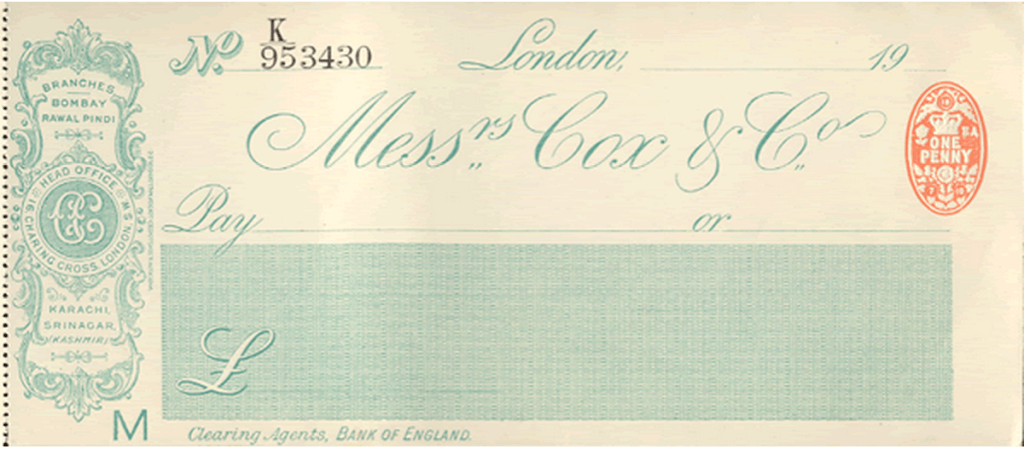A Scion Society of The Baker Street Irregulars
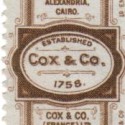
The Banking Connection: 1894 – 1994
“The Capital and Counties Bank, Oxford Street branch, are my agents.”
– The Adventure of The Priory School (PRIO)

London in 1894, when Sherlock Holmes returned from his incognito foreign journeying, was enjoying the Golden Age of British Imperial investment and expansion, bringing an enormous accretion of wealth to the Capital City of the Empire. With this background it is not surprising that banks, their customers and their activities, feature quite frequently – even prominently on occasions – in the Holmesian archives. Of the London banks with a Sherlockian connection, pride of place must, beyond all argument, be accorded to Messrs. Cox & Co. of Charing Cross.
Cox & Co.
Which of us cannot recall the thrill when we experienced our first reading of Dr. Watson’s electric opening words in Thor Bridge, a thrill we still feel whenever we have occasion to turn to them again –
“Somewhere in the vaults of the bank of Cox & Co., at Charing Cross, there is a travel-worn and battered dispatch-box with my name, John H. Watson, M.D., Late Indian Army, painted upon the lid. It is crammed with papers…”
What endless vistas are conjured up of scandals, crimes and crises, national and international, financial and personal, should it be possible for some of these explosive records to see the light of day – our latter-day political tremors and media revelations would surely seem but trifling in comparison.
Yes, Cox’s was no ordinary bank: it was in a class of its own, and in more ways than one. It began life in the mid-18th century as Agents through whom the Government of the day channelled pay for the Regiments and Services of the Armed Forces, and whilst maintaining this function it evolved into a specialist bank for serving and retired officers of the Forces. Thus it was that when in 1878 Dr. Watson was gazetted into the Army Medical Department and attached to the 5th Northumberland Fusiliers, he would automatically have had an account opened for him at Cox’s, into which his pay and allowances were henceforward credited monthly. This would have been continued during his brief attachment to the Berkshires and while hospitalized at Peshawur (Cox’s, a little later, had a branch office at nearby Rawalpindi); as also during convalescence back in England. When finally put on half-pay or pension, he would have the status of an ordinary customer at Cox’s. At the time when his account was first open, Cox & Co. were located in Craig’s Court off the end of Whitehall, but ten years later, in 1888 they moved to a new Head Office at 16-18 Charing Cross, at the junction of Whitehall and Trafalgar Square. There the bank would have been when Holmes came back to London in 1894 and there he may well at some time have made a very off-the-record call when he was particularly perturbed at the state of Watson’s finances, when just having his cheque-book under lock and key was not proving sufficient to keep things under proper control (The Dancing Men).
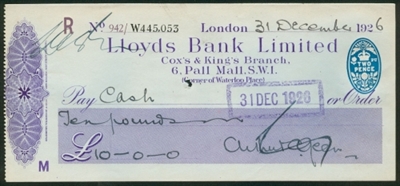
It is a great relief to all Sherlockians everywhere that although Cox & Co. moved office again in 1923 to nearby very grand premises at 6 Pall Mall, and was incorporated that same year into Lloyds Bank, it still retains its separate identity; and thankfully, Dr. Watson’s tin dispatch-box with its precious contents, is still no doubt in safe and trusted hands.
Private Banks
Another quite different category of bank which figured in more than one of Sherlock Holmes’s cases, was the old-fashioned private bank with long family antecedents and connections and a distinguished clientele of genteel and well-to-do customers. There are references and Watson’s published records to a number of such banks, but they tend to be mainly located in the Provinces. One such prestigious private bank in London (probably in a West End location such as Cavendish Square) with which Holmes had personal dealings, was Silvester’s Bank, long-established bankers to the Earl of Rufton and that family’s interests generally. Such banks usually consisted of three or four partners, often with some overall tie of relationship, who dealt with important customers on a personal, and of course completely confidential basis. No record has been preserved, unfortunately, of any of the methods used by Sherlock Holmes to gain access to details of customers’ private affairs. We know, for instance, how he managed to obtain information from such persons as a Post Office counter clerk, a Bloomsbury inn landlord, and a Hampstead Heath housemaid, but what plausible subterfuge he employed to introduce himself into the Partners’ parlour of a Private Bank we shall never know. Suffice it to say that he was shown details of Lady Francis Carfax’s account and ascertained the whereabouts of her remarkable old Spanish jewelry (carried about in her handbag, apparently). They all took place in 1899, some six years after Holmes’s return to London, and we should not really be surprised that a man who could contrive to see the head Llama in Tibet, the Shrine at Mecca and Khalifa at Khartoum (or whatever), experienced no apparent difficulty in probing the secrets of even the most conservative of business men, a Private Banker, in London.
Sherlock Holmes’s other case (The Beryl Coronet of 1886, published 1892) involving a London Private Bank, is so well-known that it has, over the years, attracted minute scrutiny in almost every detail, and there appears to be little further comment which can usefully be added, apart perhaps from the following. Watson makes no secret of the fact that the banking firm of Holder and Stevenson, of Threadneedle Street, was well known as the second largest private banking concern in the City of London, of which their client, Mr. Alexander Holder, was the senior partner. When approached by his august visitor for immediate loan of a very large sum, Mr. Holder explains that as the advance must need to be made in the name of the firm, then “in justice to his partner (sic)” he must insist on the lodgment of some form of security. This was indeed a remarkable statement, Holder’s must surely have been the only private banking firm of anything like its size and prestige in the whole City of London, either then or since, which only had two partners. On further reflection, however, was it perhaps that remarkable element of extreme privacy – the very lack of a largely based partnership necessarily privy to the loan – that had induced the client (his name was a “household word all over the earth”) to approach Holders’ Bank in preference to all others? Illustrious client’s apparent implicit faith in the privacy and confidentiality of the bank would no doubt have been even further strengthened and confirmed that he later became aware that the famous Beryl Coronet pledged to support his loan had, in the interests of security, been carried about in person by Mr. Holder, and instead of being placed in the bank’s safe, had been locked in the bureau of his own dressing-room at home. He was no doubt right to ignore his spendthrift son’s unhelpful and uncalled for comment that the bureau could “in emergency be opened by the key of the box-room cupboard or in fact “any old key”.
It only remains to say, to any individuals who may be personally interested in the subject at the present time, that a very few select private banking establishments of the old-style still do in fact exist. They carry on business in London, but now almost without exception, they operate under the protective umbrella of a larger banking group. It is, sadly, no longer possible for clients to sleep just that shade more peacefully at night in the knowledge that their treasured family heirlooms are utterly safe in their banker’s bedroom.
The Capital & Counties
We have left till almost last the matter of Sherlock Holmes’s own bank in the 1890’s and beyond. Strangely, Dr. Watson in his own reminiscences made no secret at all the fact that Holmes banked with an actual large and well-known Joint Stock bank of the day. It was the Capital & Counties Bank, which was already a familiar name to the Strand Magazine readers up and down the whole country, but particularly in London and the South. Its origins were in private country banks in Wiltshire and Hampshire which eventually opened up business in London; and in 1878 it became a Limited Joint Stock Bank under the new name of The Capital and Counties Bank (with five London branches). This was an era of enormous and rapid change in the banking scene in London and the Country as a whole. The new Joint Stock banks (with Limited Liability for Shareholders) were rapidly buying up the old private banks. Amalgamated banks appeared with attractive “Uncle Tom Cobleigh” names such as London County Westminster & Parr’s Bank; London Joint City & Midland Bank; National Provincial & Union of London & Smith’s Bank; Barclay, Bevan, Tritton, Ransom Bouverie’s & Co. These were the banking counterparts of the contemporaneous Railway Companies such as the London, Brighton & South Coast Railway, and the London, Chatham & Dover Railway.
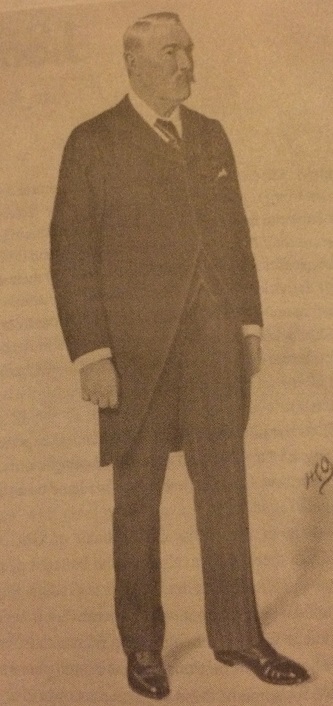
Capital & Counties itself acquired a further 33 banks between 1883 and 1900, and at the same time it also opened some 70 new branches of its own. (Curious, that 100 years later, the banks are closing them again, just like the railways.) The driving force behind this expansion in the 1880’s and 1890’s was Edward Baverstock Merriman (of Savernake, Marlborough) who became a director at the age of 26 and ruled as Chairman from 1885 right through till his death in 1915. The Bank’s History records that “the business of amalgamation and expansion was very much Merriman’s own personal work, directed by his own quill-penned letters from the new main office in Threadneedle Street, where he reigned, a terror to the juniors, for 39 years.” He was extraordinarily versatile and active: he was Colonel of the Volunteer Battalion Duke of Edinburgh’s Wiltshire Regiment, rode to the Tedworth Hounds and was described in Mayfair as “living proof of the adage that the best sportsmen are the best businessman”. In 1914 he was called into consultation by Whitehall on the outbreak of the Great War; and “for banking services performed for the Portuguese Government he received the Portuguese Knighthood of the Royal Military Order of Our Lady of the Conception.” What the services were has remained secret, but the whole matter is highly intriguing, involving as it does some unusual link between “an erstwhile country–solicitor–banker” and the Government of a friendly Foreign Power. What gives the foregoing its special interest is, firstly, the resemblance, some might say, to amalgam of Sherlock Holmes and Sir Arthur Conan Doyle; and secondly, the choice of Everett Merriman’s thrusting bank, the Capital & Counties, by Sherlock Holmes to be his own bank (as also, incidentally, Conan Doyle for his). Holmes was always unmistakably a man of the future and whilst he respected the past in the shape of the old-established institutions of the private banks, he knew that the teacher lay with the up-and-coming and go-ahead joint-stock banking companies.
What is indisputable is that Sherlock Holmes was a Capital & Counties man through-and-through and whenever a specific bank account formed some part of the action, it somehow usually happened that the account proved to be kept at the appropriate Capital & Counties branch. In point of fact, the first three branches opened in the London area by the bank in 1876 (in the name of the Hampshire Banking Company, before the name was changed to Capital & Counties in 1878) are the very three which figure in the Holmesian Canon. In The Bruce-Partington Plans, a cheque book on the Woolwich Branch was found on poor Cadogan West’s body in 1895. In The Priory School, Holmes reveals, in 1901, that his own bank account was at the Oxford Street Branch; and in The Man With The Twisted Lip, it would appear that it was at the Threadneedle Street Office that Neville St. Clair, in 1889, was most likely to have kept his account. As regards this latter case, the only other branches then open were Covent Garden, Ludgate Hill, Oxford Street, Paddington and Woolwich, and all of these (with the possible exception of Ludgate Hill) were too far away for him to have first changed out of his disguise in the Bar of Gold in Upper Swandam Lane, then paid in his takings for the day (a very slow process – counting the coins) at his Bank, and finally to have got back to Cannon Street Station in time to catch the 5.14 train home. Of course there was the danger that the Threadneedle Street Office was only a matter of yards from his profitable begging-pitch; but as against this, if he had kept his accounts somewhat further away at the Oxford Street branch, the case might never have got off the ground at all, should he have happened to bump into his fellow customer, fellow actor and fellow master of disguise, Sherlock Holmes himself.
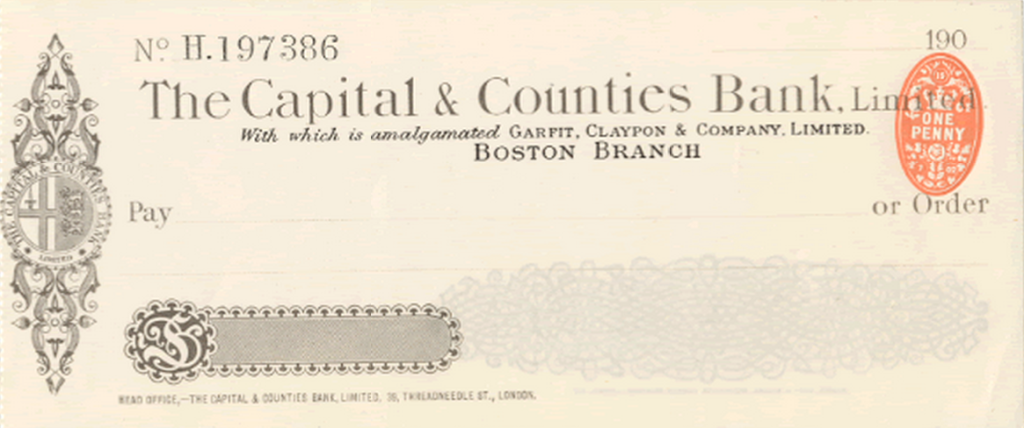
Reverting to The Priory School affair, there is one rather unusual point to be noted. When Holmes asks the Duke of Holdernesse for his cheque for 6000, Holmes indicates his wish that it should be crossed Capital & Counties Bank, Oxford Street Branch, whom he refers to as his “agents”. The use of this particular word is interesting. The word “agent” was universally used when one bank used another bank to collect or clear cheques on its behalf. However, the Bank of England, which had four or five specialist branches (e.g. the Law Courts Branch in London), use the very select term of “Agent”, rather than just “Manager”, for its presiding Official. One wonders, did Sherlock Holmes, as he contemplated His Grace’s cheque, drawn no doubt on one of the exclusive aristocratic Private Banks, succumbed just for that brief moment, to the subtle temptation to “keep up with the Ducal Jones’s” and endow his bank with a loftier title of Agents, so as to get some extra cachet to the rather upstart, plebeian and mass-production-sounding name of the Capital & Counties? We can only guess. Sadly, the 125 Oxford Street Branch bank which Holmes knew so well over the years, and which survived the amalgamation with Lloyds Bank in 1918, has been the victim of the inexorable march of progress, and the former premises at the corner of Wardour Street and Oxford Street have now acquired the status of a fashion shop (not the only one in Oxford Street!). No matter: for Sherlock Holmes himself the Capital & Counties was always the bank.
The City & Suburban
There was, it is true, a rival concern, the City & Suburban Bank (or whatever Bank it was that masqueraded that title), but this only figures in the one case, in 1890, which involve the bank itself (The Red-Headed League). In this case the star player is very much Sherlock Holmes, the brilliant reasoner and detective; Mr. Merryweather, Chairman of the Bank’s Directors, is rather an unimaginative and reluctant member of the cast. By an extraordinary turn of fate, eighty-one years later, in 1971, the strong room of a London branch bank (actually in Baker Street, incredibly) was successfully broken into from the basement of shop premises acquired for the purpose, two doors away. The Press made much of the cleverly-organized copycat criminal operation, and lamented the fact that Sherlock Holmes had not been around to foil the miscreants’ all-to-successful nefarious plans. Bankers in Baker Street in 1994 would no doubt be relieved if they could welcome Sherlock Holmes back to number 221b, but unfortunately, hard facts must be faced. Dr. Watson’s bankers feel, quite properly, that they have no authority to divulge his present address and would hesitate even to forward correspondence; the well-tried mode of communication with Holmes via the Post Office Telegraphic Service is no more; and he himself, it is learnt, has let it be known, in the latest reprint of his magnum opus on Apiculture, that the suggested installation of a fax machine at his Sussex Cottage could prove highly deleterious to any future Observations on the Segregation of the Queen. So, as always, after elimination of the impossible, then whatever remains, however improbable, must be the truth. And yet! – And yet!
Postscript
In 1971, the Writer was in touch with a retired Official of the Bank of England, then aged 96, who had previously been on the staff of the Capital & Counties Bank from 1893 to 1900. A colleague of his at that time had actually served for a year or two at the 125 Oxford Street Branch, and he remembered him saying that “it was an extremely busy branch.”
Extremely busy? That is what we may expect to be when we follow Mr. Sherlock Holmes.
Bibliography:-
Gavin Brend: My Dear Holmes (Allen & Unwin; 1951).
D. Martin Dakin: A Sherlock Holmes Commentary (David & Charles; 1972).
J.O. Duval: Cox & Co. at Charing Cross (Penacook, New Hampshire; 1981).
L. Poleske: Sherlock Holmes and Cheques in Check Collector, 1991.
R.S. Sayers: Lloyds Bank in the History of English Banking (Oxford; 1957).
 This post was originally published as a chapter in the Sherlock Holmes Society of London’s book, Back To Baker Street: An Appreciation of Sherlock Holmes & London. Thanks to Roger Johnson, the Co-Editor of the volume (and 48th Garrideb) for allowing us to reprint it here.
This post was originally published as a chapter in the Sherlock Holmes Society of London’s book, Back To Baker Street: An Appreciation of Sherlock Holmes & London. Thanks to Roger Johnson, the Co-Editor of the volume (and 48th Garrideb) for allowing us to reprint it here.
James R. Cuthbertson was born in London in 1912, when there were still 15 more Sherlock Holmes stories yet to be published. A member of the Sherlock Holmes Society of London since 1962, Cuthbertson, in 1989 wrote and published A Study In Banking: An Investigation of the Relationship of Mr. Sherlock Holmes with His Bank, to which this [1994] article may be considered an addendum. A retired banker, Cuthbertson’s office in the Old Partner’s Room at Drummonds Bank at Charing Cross faced the former premises of Cox and Co. (at one time Cox and Drummond), Dr. Watson’s bankers. Cuthbertson passed away in August 1997.

